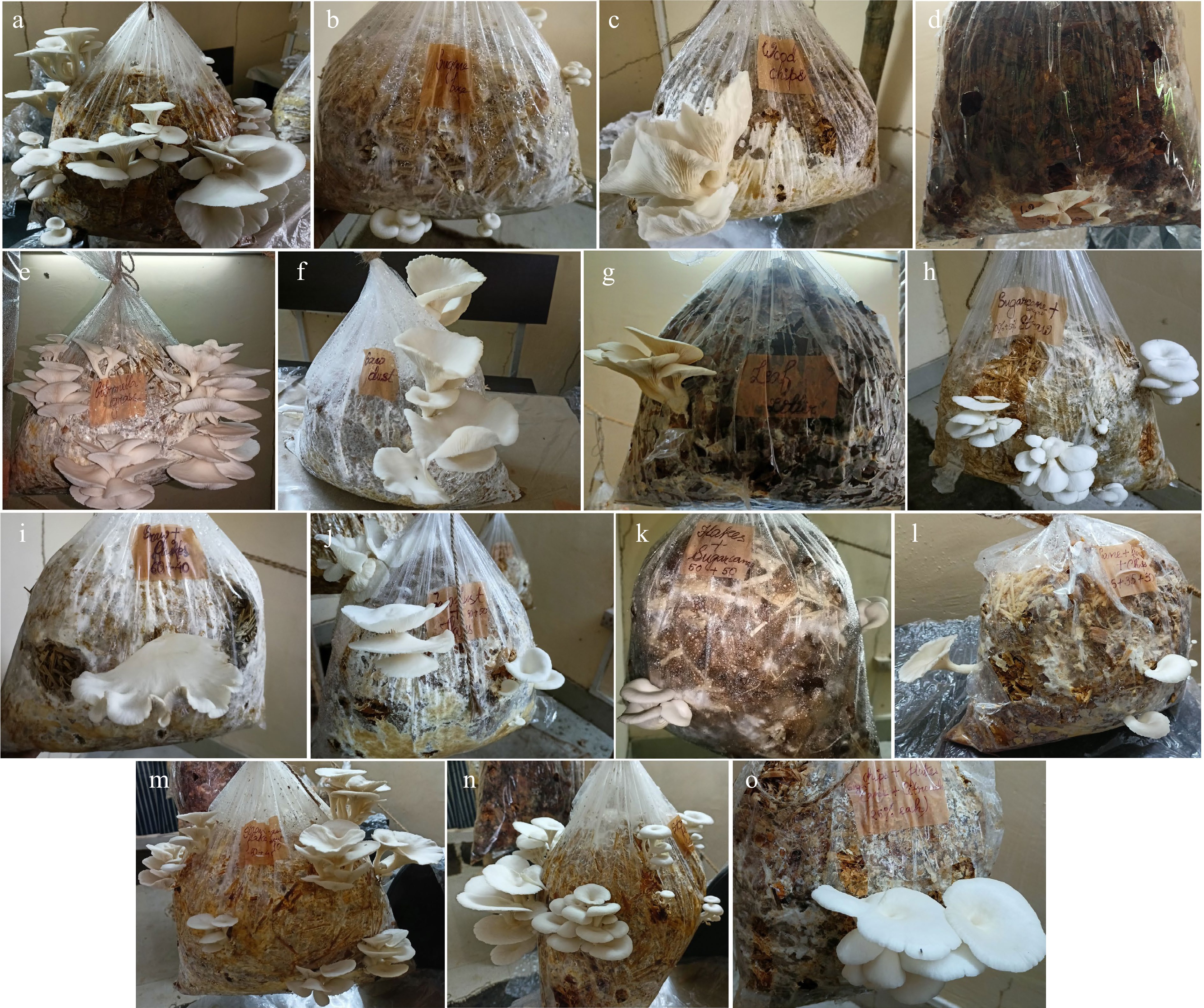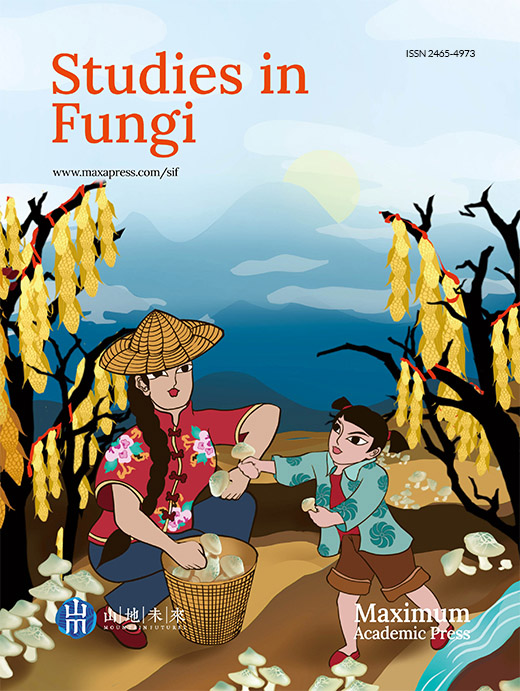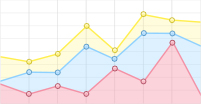-
Lignocellulosic wastes constitute a major portion of plant biomass and are generated in huge amounts annually in various sectors like agriculture, forestry and the food industry. These wastes consist of rich organic compounds and are worthy of being recovered and transformed[1]. Despite their usability, only a small fraction of the total waste is utilized and a major portion is left unused. Some of them are disposed in open dumps or burnt, resulting in emission of black carbon causing serious environmental pollution. Therefore, the utilization of these lignocellulosic wastes into profitable products has become one of the major objectives at present. Mushroom cultivation using lignocellulosic wastes could be one of the most economical and eco-friendly techniques for the conversion of these wastes into profitable products. Mushrooms are an excellent source of protein that can be a substitute for meat for vegetarians. Mushrooms contain about 85%–95% water, 3% protein, 4% carbohydrate, 0.1% fat, 1% minerals and vitamins[2].
Amongst various mushrooms, Pleurotus spp. (Oyster mushroom) can be cultivated on a wide range of lignocellulosic substrates. Therefore, cultivation of this mushroom species needs to be popularized so that unused lignocellulosic waste can be properly utilized for mushroom production. Oyster mushrooms are widely consumed worldwide and are regarded as a nutritious food option due to both its nutritional and medicinal properties. Over the past few decades, there has been a global trend toward the cultivation of significantly greater numbers of oyster mushrooms[3,4]. After button mushrooms, oyster mushrooms are the most common type of mushroom consumed[5]. The cultivation process of oyster mushrooms is cost-effective because of its easy cultivation techniques using substrates that are locally available[6,7]. Various agro-wastes have been utilized to cultivate the edible mushroom out of which paddy straw and wheat straw are the most common. The other substrates include sawdust, sugarcane, corn cob, corn stalks, leaves, and the pseudo stem of banana[8−10].
This study aims to investigate the yield and biological efficiency of the selected substrates and their combination on the productivity of Pleurotus ostreatus (Jacq.) P. Kumm through the usage of various locally accessible and unused lignocellulosic waste for its cultivation.
-
Seven agricultural and plant-based lignocellulosic wastes were collected from agro-based and paper and pulp industries in Guwahati, Assam, India. The seven individual substrates and their combinations were T1 = rice straw, T2 = sugarcane bagasse, T3 = wood chips, T4 = wood flakes, T5 = citronella bagasse [Cymbopogon nardus (L.) Rendle], T6 = sawdust, T7 = leaf litter [Monoon longifolium (Sonn.) B.Xue & R.M.K. Saunders], and the combinations includes: T8 = rice straw + sugarcane bagasse (50% + 50%), T9 = Rice straw + wood chips (60% + 40%), T10 = wood flakes + sawdust (50% + 50%), T11 = wood flakes + sugarcane bagasse (80% + 20%), T12 = wood flakes + sugarcane bagasse + woodchips (35% + 35% + 30%), T13 = rice straw + wood flakes + sawdust (50% + 40% + 10%) and T14 = citronella bagasse + sugarcane bagasse + wood flakes + wood chips (25% each).
Preparation of substrate
-
Each bag contained 1 kg of the collected materials as substrates. Firstly, the collected materials were cut into small pieces of 2–3 cm and thoroughly washed with normal water followed by surface sterilization with hot water treatment. After rinsing, the substrates were separately packed in polypropylene bags of 45 cm × 30 cm, autoclaved and then allowed to cool.
Preparation of mushroom beds and spawning
-
The spawn of Pleurotus ostreatus was collected from Assam Agriculture University of Kahikuchi campus, Guwahati, India. After cooling, the substrates were mixed with gram flour (8 g/kg substrate) and stacked in three layers in a separate clean polypropylene bag. Between each stacking layer, spawning was done on the entire surface of the beds. A number of holes (measuring ca. 2 mm in diam.) were created to maintain an aerobic condition.
Incubation
-
The bags were incubated by hanging them in a closed room with ventilation kept open throughout along with an exhaust fan, at a temperature ranging from 25–28.5 °C. Water was sprinkled regularly to maintain moisture.
Harvesting and determination of yield
-
After complete colonization, longitudinal slits were made to facilitate the proper development of fruiting bodies. Harvesting of the fruiting bodies was done on the fourth day after the appearance of pinheads. The mycelial growth, complete colonization, primordial initiation, and yield in terms of biological efficiency were recorded. Biological Efficiency (B.E) was calculated as the percentage of yield of fresh mushrooms in relation to the dry weight of the substrate as given by Chang & Miles[11].
Biological efficiency (B.E.) in % = yield of fresh mushroom (in gm)/ total weight of the dry substrate (i.e., 1,000 gm) × 100
Statistical analysis
-
Statistical analyses were performed for the comparison of treatment means of the first mycelial growth, complete mycelial colonization, pin-head initiation, the time required for first harvesting, yield and biological efficiency. The Shapiro-Wilk Normality Test was pre-performed to check for the goodness of fit normality of the data. Accordingly, after the log transformation of the original data, it eventually follows the assumption of normality. After that, the transformed data are implemented in a Completely Randomized Design with fourteen different substrates with three replications each and the analysis of variance (one-way ANOVA) along with a multiple comparison test viz. Least Significant Difference for comparison of the pairs of treatments using the RStudio version 1.2.1335. The primary software packages used in the analyses are agricolae, DescTools, ggplot2, tidyverse and dplyr.
-
In this study, Pleurotus ostreatus growth and yield were determined using seven lignocellulosic wastes and their combinations in varied proportions. The result showed that first mycelial growth in different substrates and their combinations ranged from 1.00–2.67 d (Table 1). The lowest day of first mycelial growth was observed on T5 and T14 substrates. Among all the substrates, T6 showed a significantly higher time for the appearance of first mycelial growth. Further, the time required for the appearance of the first mycelial growth was similar in T2, T3, T7 and T11. Similar trends were also observed in the other substrates as well. The study indicated that there was a significant effect of substrates on mean first mycelial growth (p-value = 0.04). Analysis using the Least Significant Difference (LSD) showed that the T6 substrate took a longer mean time for first mycelial growth (2.67 d).
Table 1. Effect of substrates on the mycelial growth of Pleurotus ostreatus.
Substrates First mycelial growth
in the substrate (d)Time required for completion
of mycelial running (d)T1 = Rice straw 1.67abc 16.33de T2 = Sugarcane bagasse 2.33ab 15.67ef T3 = Wood chips 2.33ab 26.00b T4 = Wood flakes 1.67abc 17.33de T5 = Citronella bagasse 1.00c 16.33de T6 = Sawdust 2.67a 20.00c T7 = Leaf litter 2.33ab 24.67b T8 = Rice straw + sugarcane bagasse (50% each) 1.33bc 14.00f T9 = Rice straw + wood chips (60% + 40%) 1.33bc 17.33de T10 = Wood flakes + sawdust (50% each) 1.67abc 28.67a T11 = Wood flakes + sugarcane bagasse (80% + 20%) 2.33ab 18.00cd T12 = Wood flakes + sugarcane + wood chips (35% + 35% + 30%) 1.33bc 15.33ef T13 = Rice straw + wood flakes + sawdust (50% + 40% + 10%) 1.33bc 18.33cd T14 = Citronella bagasse + sugarcane bagasse + wood flakes + wood chips (25% each) 1.00c 17.00de Significance * *** CV (%) 82.42 1.50 Treatments followed with the same letter are not significantly different by LSD (Least Significance Difference) test at a 5% level of significance. From Table 1, it was observed that the completion of mycelial running in different substrates and their combinations ranged from 14.00–28.67 d. The lowest days of completion of mycelial running were observed on the T8 substrate i.e., 28.67 d. Again, among all substrates, T10 showed a significantly higher mean first completion of mycelial running (28.67 d) and this observation is also supported by the LSD analysis. The T1, T2, T4, T5, T9 and T14 substrates were not significantly different from each other and similar result was observed for the remaining substrates as well. There was a significant effect of substrates on mean complete mycelial running (p-value ≤ 2e-16).
First pinhead initiation in different substrates and their combinations ranged from 18.67–34.00 d (Table 2). The lowest days of the first pinhead initiation were observed on T2 and T8 substrates. Substrates T3, T7, and T10 showed considerably longer mean initial pinhead initiation times than the other substrates. The remaining substrates were not significantly different from each other in terms of first pinhead initiation. However, there was significant effect of the substrates on the first pinhead initiation (p-value ≤ 2e-16). Similar to previous studies, LSD analysis showed that the T10 substrate took the longest duration for first pinhead initiation among all substrates (34.00 d).
Table 2. Effect of different substrates on first pin-head initiation and the time required for the first harvest.
Substrates Time required for first
pin- head initiation (d)Time required for
first harvesting (d)T1 = Rice straw 23.33b 26.33b T2 = Sugarcane bagasse 18.67d 21.67d T3 = Wood chips 33.33a 36.33a T4 = Wood flakes 22.67bc 24.67bc T5 = Citronella bagasse 23.33b 26.33b T6 = Sawdust 20.00d 23.00d T7 = Leaf litter 33.00a 36.00a T8 = Rice straw + sugarcane bagasse (50% each) 18.67d 21.67d T9 = Rice straw + wood chips (60% + 40%) 22.00bc 25.00bc T10 = Wood flakes + sawdust (50% each) 34.00a 37.00a T11 = Wood flakes + sugarcane bagasse (80% + 20%) 21.67c 24.67c T12 = Wood flakes+ sugarcane + wood chips (35% + 35% + 30%) 20.00d 23.00d T13 = Rice straw + wood flakes + sawdust (50% + 40% + 10%) 22.67bc 25.67bc T14 = Citronella bagasse + sugarcane bagasse + wood flakes + wood chips (25% each) 22.00bc 25.00bc Significance *** *** CV (%) 3.98 3.53 Treatments followed with the same letter are not significantly different by LSD (Least Significance Difference) test at a 5% level of significance. The first harvest in different substrates ranged from 21.67–37.00 d (Table 2). T2 and T8 substrates needed the least time (21.67 d) for the first harvest out of all the substrates. However, T3, T7, and T10 substrates required much more time than other substrates. Similar to the previous finding, T10 had a mean first harvest of 37.00 d, which was longer than the other substrates (p-value = 2e-16). After the pin head initiation, harvesting was done within a week (Fig. 1). A total of four harvests were made depending upon the yield on different substrates. The results showed that the first harvest in different substrates and their combinations ranged from 13.50–222.43 gm (Table 3).

Figure 1.
Growth of Pleurotus ostreatus on different substrates (a) T1 = rice straw, (b) T2 = sugarcane bagasse, (c) T3 = wood chips, (d) T4 = wood flakes, (e) T5 = citronella bagasse (Cymbopogon nardus), (f) T6 = sawdust, (g) T7 = leaf litter (Monoon longifolium), (h) T8 = rice straw + sugarcane bagasse (50% + 50%), (i) T9 = rice straw + wood chips (60% + 40%), (j) T10 = wood flakes + sawdust (50% + 50%), (k) T11 = wood flakes + sugarcane bagasse (80% + 20%), (l) T12 = wood flakes + sugarcane bagasse + woodchips (35% + 35% + 30%), (m−n) T13 = rice straw + wood flakes + sawdust (50% + 40% + 10%), and T14 = Citronella bagasse + sugarcane bagasse + wood flakes + wood chips (25% each).
Table 3. Effect of different substrates and substrate combinations on yield of Pleurotus ostreatus.
Substrates Weight of the fruiting bodies (in gm) Net weight
(in gm)1st harvest 2nd harvest 3rd harvest 4th harvest T1 = Rice straw 131.67c 163.33b 90.00b 14.70b 399.70a T2 = Sugarcane bagasse 14.86ij 8.55i − − 23.41j T3 = Wood chips 63.17e 22.84g − − 86.01g T4 = Wood flakes 13.50j 5.63i 3.33d − 22.45j T5 = Citronella bagasse 222.43a 123.73c 47.75c − 393.90b T6 = Sawdust 161.56b 15.20h − − 176.76d T7 = Leaf litter 23.33h 13.05h − − 36.38i T8 = Rice straw + sugarcane bagasse (50% each) 50.73f 77.51d − − 128.24f T9 = Rice straw + wood chips (60% + 40%) 17.56i − − − 17.56k T10 = Wood flakes + sawdust (50% each) 65.81e 71.74e − − 137.55a T11 = Wood flakes + sugarcane bagasse (80% + 20%) 13.54j − − − 13.54l T12 = Wood flakes + sugarcane + wood chips (35% + 35% + 30%) 53.23f 25.12g − − 78.35h T13 = Rice straw + wood flakes + sawdust (50% + 40% + 10%) 83.55d 203.97a 104.97a − 392.49b T14 = Citronella bagasse + sugarcane bagasse + wood flakes + wood chips (25% each) 32.34g 66.09f 106.80a 66.67a 271.90c Significance *** *** *** *** *** CV (%) 3.36 3.30 5.58 5.66 1.16 Treatments followed with the same letter are not significantly different by LSD (Least Significance Difference) test at a 5% level of significance. T4 and T11 substrates had the lowest first harvest yield of 13.50 gm, whereas the T5 substrate had the highest mean yield. T3 and T10 substrates yielded similarly in the first harvest. Other substrates had similar first-harvest yields. The study indicated that there was a significant effect of substrates on the mean yield of the first harvest (p-value ≤ 2e-16). Least Significant Difference (LSD), analysis showed that T5 substrates produced the highest mean yield of the first harvest (i.e., 222.43 gm).
The yield of the second harvest ranged from 5.63–203.97 gm (Table 2). The lowest yield of the second harvest was observed on T2 and T4 substrates i.e., 5.63 and 8.55 gm, respectively. Among the substrates, T13 a showed significantly higher mean yield in the second harvest (203.97 gm). Similar to the previous observations, there was a significant effect of substrates on the mean yield of the second harvest (p-value = 1.01e-0.5).
The yield of the third harvest ranged from 3.33–106.80 gm (Table 3). The lowest yield in the third harvest was observed on the T4 substrate i.e., 3.33 gm, while the highest yield in the third harvest was recorded in T13 and T14 substrates. The results revealed a significant effect of substrates on the mean yield of the third harvest (p-value = 6.88e-11). However, LSD analysis showed that the T14 substrate gave the highest mean yield in the third harvest (106.80 g).
T1 and T14 substrates yielded 14.70 and 66.67 gm in the fourth harvest (Table 3). The yield of the total harvest in different substrates and their combinations ranged from 13.54–399.70 gm. T11 substrate had the lowest harvest yield of 13.54 gm. T1 and T5 substrates had higher average harvest yields, but T1 had the highest overall yield (399.70 gm).
The effect of different substrates and their combination on the yield of Pleurotus ostreatus was determined in terms of biological efficiency. From Table 4, it was observed that biological efficiency ranged from 1.35%–39.40%. The lowest biological efficiency was observed in T11 and the highest was that on T1, respectively. The higher the total yield, the higher the biological efficiency. It was observed that there was a significant effect of substrates on the mean biological efficiency of substrates and their combinations (p-value ≤ 2e-16). Using Least Significant Difference (LSD) analysis, the additional study revealed that T1 was connected to the highest mean biological efficiency (39.40%). In the present study, the highest biological efficiency of P. ostreatus was observed on Straw (39.40%) followed by Citronella (39.39%) and the T13 substrate (rice straw 50%, wood flakes 40%, and sawdust 10%) (39.25%). The lowest B.E. of 1.35% was observed on wood flakes (80%) plus Sugarcane bagasse (20%) substrate combination.
Table 4. Yield of Pleurotus ostreatus in terms of biological efficiency.
Substrates Biological
efficiency (%)T1 = Rice straw 39.40a T2 = Sugarcane bagasse 2.34j T3 = Wood chips 8.60g T4 = Wood flakes 2.25j T5 = Citronella bagasse 39.39b T6 = Sawdust 17.68d T7 = Leaf litter 3.64i T8 = Rice straw + sugarcane bagasse (50% each) 12.82f T9 = Rice straw + wood chips (60%+40%) 1.76k T10 = Wood flakes + sawdust (50% each) 13.76a T11 = Wood flakes + sugarcane bagasse (80% + 20%) 1.35l T12 = Wood flakes + sugarcane + wood chips (35% + 35% + 30%) 7.83h T13 = Rice straw + wood flakes + sawdust (50% + 40% + 10%) 39.25b T14 = Citronella bagasse + sugarcane bagasse + wood flakes + wood chips (25% each) 27.19c Significance *** CV (%) 1.16 Treatments followed with the same letter are not significantly different by LSD (Least Significance Difference) test at a 5% level of significance. -
The choice of substrate significantly influenced the yield of Pleurotus ostreatus. In our study, most of the substrates used for the cultivation were lignocellulosic wastes, and similar work was also carried out by Zadrazil[12] where several unused agro-wastes in the form of straws, leaves, stems, roots, etc. were selected for the cultivation of mushroom. Our finding showed that although T5 and T14 substrates required the fewest days for the first mycelial growth, the T8 substrate required the least days for the first mycelial running over the substrate. The substrate combination (T10), which was a combination of wood flakes and sawdust in equal amounts, dried out after the initial flushing since it had a lower water retention capacity and moisture content[13]. Similarly, supplementation of mushroom beds with gram powder provided a better yield of mushrooms as earlier reported by Bano et al.[8]. It was observed that the total yield of Oyster mushrooms on lemon grass (Cymbopogon citratus) after three flushes was 264.80 gm on 1 kg of substrate[14]. The yield of fruiting bodies on T5 substrate, or Citronella bagasse (Cymbopogon nardus) was 393.90 gm on 1 kg of the substrate after three flushes, which is significantly higher than the yield on lemon grass reported by Mumtaz et al.[14]. The biological efficiency of mushrooms varied significantly in different substrates and their combinations. In many instances, the production of mushrooms was found to be low as the substrates accounted for various changes like temperature, the activity of microbes, and aeration that affected the mushroom production.
-
We thank Mr. Ratnadeep Sharma, Department of Statistics, Gauhati University (India) for his immense effort and help in carrying out the statistical data analysis of our present study.
-
The authors declare that they have no conflict of interest.
- Copyright: © 2023 by the author(s). Published by Maximum Academic Press, Fayetteville, GA. This article is an open access article distributed under Creative Commons Attribution License (CC BY 4.0), visit https://creativecommons.org/licenses/by/4.0/.
-
About this article
Cite this article
Biswas PR, Boro H, Doley SN, Dutta AK, Tayung K. 2023. Evaluation of different lignocellulosic-wastes and their combinations on growth and yield of Oyster mushroom (Pleurotus ostreatus). Studies in Fungi 8:7 doi: 10.48130/SIF-2023-0007
Evaluation of different lignocellulosic-wastes and their combinations on growth and yield of Oyster mushroom (Pleurotus ostreatus)
- Received: 25 November 2022
- Accepted: 21 March 2023
- Published online: 12 April 2023
Abstract: Lignocellulose wastes are generated in huge amounts by various sectors like agriculture, forestry, and industry but only a small portion of these wastes are utilized and a major portion is left unused. In this study, seven different lignocellulosic wastes and their combinations in different percentages were determined for the growth and yield of Pleurotus ostreatus. The maximum growth and yield of P. ostreatus were observed on a substrate made of rice straw, with a total yield of 399.70 gm per kg of substrate. The least growth and yield were recorded on a substrate made of wood flakes and sugarcane bagasse (80% + 20%), with a total yield of 13.54 gm per kg of substrate. Rice straw showed the highest biological efficiency (B.E) of 39.40, whereas wood flakes and sugarcane bagasse (80% + 20%) had the lowest B.E. of 1.35. Other substrates had a moderate effect, and citronella bagasse (Cymbopogon nardus), which was used as a substrate for the first time, gave a biological efficiency of 39.39 gm per kg substrate. The results showed a significant effect of substrates on mean yield and biological efficiency. Our study revealed that lignocellulosic waste can be profitably utilized for mushroom cultivation and could be one of the most economical and eco-friendly techniques.
-
Key words:
- Agro-wastes /
- Biological efficiency /
- Mycelial growth /
- Pin-head












